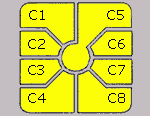Difference between revisions of "Dual SIM project"
(Created page with "Our net router is about two hundred metres away from the house at the top of a hill for our rural net connection. We'd like to use the connection for both net and phone ca...") |
(→The remote switching method: ISO 7816-3) |
||
| (2 intermediate revisions by the same user not shown) | |||
| Line 22: | Line 22: | ||
|C8||NC||''Reserved'' | |C8||NC||''Reserved'' | ||
|} | |} | ||
| + | |||
| + | == The physical connection == | ||
| + | We probably would be using the SIMs only for use at the land so it's probably ok to just solder them into place, but if it's not too difficult it would be nice to create a system whereby the two SIMs can be removed or replaced easily. | ||
== The remote switching method == | == The remote switching method == | ||
| − | The switching itself may be able to be done with a | + | The switching itself may be able to be done with a basic TTL logic chip and some diodes. The data is transmitted bidirectionally using the protocols described in [http://www.cardwerk.com/smartcards/smartcard_standard_ISO7816-3.aspx ISO 7816-3]. |
| + | |||
| + | If the logic chip is too complicated or doesn't work, then a solid-state relay would definitely do the trick. | ||
In the house we would then have two switches for controlling the router; one for the power and one for determining which SIM is currently active. To change SIMs the router would be turned off, the SIM switch setting changed, and the router powered back up again. | In the house we would then have two switches for controlling the router; one for the power and one for determining which SIM is currently active. To change SIMs the router would be turned off, the SIM switch setting changed, and the router powered back up again. | ||
[[Category:Projects]][[Category:Our rural net connection]] | [[Category:Projects]][[Category:Our rural net connection]] | ||
Latest revision as of 01:30, 22 May 2013
Our net router is about two hundred metres away from the house at the top of a hill for our rural net connection. We'd like to use the connection for both net and phone calls and the router has a connection for a phone cable which we can connect to one of the spare pairs in the Ethernet cable so we can have a phone in the house. But unfortunately our telco Vivo doesn't provide any plan that has practical prices for both net data and phone calls. To get around this problem we need to have two separate SIM cards and a means of remotely switching between them from the house.
SIM card pinouts
It looks from these pin connections that all of them except for pin 7 (the I/O pin) could connect to both SIMs concurrently without any problems since only the I/O pin would ever be expecting anything coming back into the device that would cause a potential conflict between the two. So our switching mechanism could then just connect the I/O pin from one or the other SIM card to the pin 7 connection in the device leaving all the others permanently connected.
| Pin | Use | Notes |
|---|---|---|
| C1 | Vcc | +5vdc |
| C2 | RST | Reset signal, used to reset the card's communications. |
| C3 | CLK | Provides the card with a clock signal, from which data communications timing is derived. |
| C4 | NC | Reserved |
| C5 | Gnd | |
| C6 | Vpp | Non-volatile memory programming voltage input. |
| C7 | I/O | Input or Output for serial data (half-duplex) to the integrated circuit inside the card. |
| C8 | NC | Reserved |
The physical connection
We probably would be using the SIMs only for use at the land so it's probably ok to just solder them into place, but if it's not too difficult it would be nice to create a system whereby the two SIMs can be removed or replaced easily.
The remote switching method
The switching itself may be able to be done with a basic TTL logic chip and some diodes. The data is transmitted bidirectionally using the protocols described in ISO 7816-3.
If the logic chip is too complicated or doesn't work, then a solid-state relay would definitely do the trick.
In the house we would then have two switches for controlling the router; one for the power and one for determining which SIM is currently active. To change SIMs the router would be turned off, the SIM switch setting changed, and the router powered back up again.








